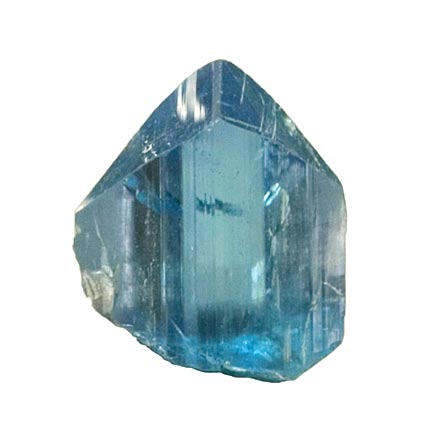| Crystal system | Monoclinic |
| Transparency | Transparent |
| Luster | Vitreous (pearly on cleavage surface) |
| Fracture | Conchoidal |
| Cleavage | perfect pinacoidal |
| Specific Gravity | 3.10 |
| Hardness | 7.5 |
| Optical Character | Biaxial + ; Double Refractive |
| Refractive index | 1.654-1.673 |
| Birefringence | 0.019 |
| Dispersion | 0.016 |
| Fluorescence | |
| Pleochroism | Weak; Blue stones: bluish gray & light blue. Green stones: grayish green & green. |
| Chemical Formula | Be2Al2(SiO4)2(OH)2 |
| Comments | |
| Streak | |
Euclase (YOU-clays) is a silicate of beryllium and aluminum, cut stones of which resemble beryl somewhat in appearance. The formula is Be2Al2(SiO4)2(OH)2. It occurs in rather pale tones of bluish or yellowish green, but may also be pale yellow or violet; rarely, it is encountered in deeper tones of blue-green. Although this mineral has the requisite hardness (7 1/2) and beauty to be an important gemstone, its perfect cleavage and great rarity have kept it from attaining this position in the world of gems.
The name euclase is derived from the Greek word meaning "good cleavage".
Euclase has been found in a number of places, the most important of which is the pegmatite dikes near the town of Rodriguez Silva in Minas Gerais, Brazil, where it is associated with yellow topaz. It has also been found in placer deposits in the Sanaeka River in the Ural Mountains of Russia, as well as in Kashmir, Tanzania, and Colombia.
Well-formed, attractive monoclinic crystals of prismatic habit are typical of euclase. The luster is vitreous and, like epidote, somewhat pearly on cleavage faces. Refractive indices are 1.654 and 1.673, although they may increase to as much as 1.658 and 1.677. The lowest values encountered have been 1.651 and 1.671. The usual birefringence is .019 and the optic character is biaxial positive. Pleochroism in blue stones is a weak bluish gray and light blue; in green stones, grayish green and green. The value for dispersion is .016. Euclase has a conchoidal fracture, a white streak and an S.G. of 3.10. It exhibits no phenomenon and contains no inclusion that can be considered characteristic. In the flame of the jeweler's torch or the blowpipe the mineral fuses; also, it is attacked by acids. It is distinguished easily from aquamarine by the difference in R.I. and S.G., and from corundum and topaz by the same means.
Euclase is valued highly by mineralogists for its lovely crystals; fine specimens are more often acquired by crystal collectors than by lapidaries for cutting. Because of this, and because of its rarity, fashioned stones command substantial prices.
Step and mixed cuts are used for cuttable material. Because of its perfect cleavage, stones must be oriented so that a facet is not placed on a cleavage plane. Also, they must be oriented for the most attractive color. Linde A powder on a tin lap, crown angles of 43° and pavilion angles of 39° are recommended.


